
92 Percent of Greenland’s Residents Believe Climate Change Is Happening
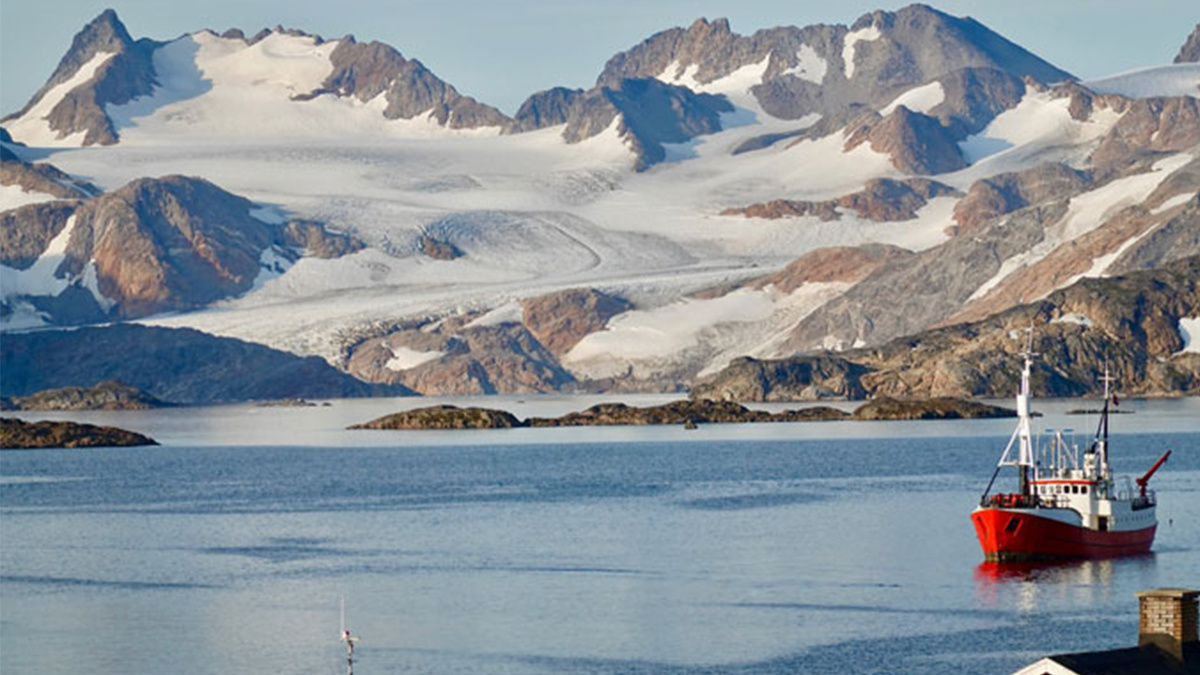
The Apusiaajik Glacier, as seen from Kulusuk village in East Greenland. Like most glaciers in Greenland, it's retreating rapidly, changing the local landscape year by year. Photo credit: Karin Kirk
By Karin Kirk
Greenland had quite the summer. It rose from peaceful obscurity to global headliner as ice melted so swiftly and massively that many were left grasping for adjectives. Then, Greenland’s profile was further boosted, albeit not to its delight, when President Trump expressed interest in buying it, only to be summarily dismissed by the Danish prime minister.
During that time I happened to be in East Greenland, both as an observer of the stark effects of climate change and as a witness to local dialogue about presidential real estate aspirations, polar bear migrations and Greenland’s sudden emergence as a trending topic.
While attention buzzed around Greenland, some key voices were absent: those of the Greenlanders themselves. This autonomous territory of Denmark is home to 56,000 people, most of whom are Greenlandic Inuit. What are their thoughts about climate change?
A cohort of Danish and Greenlandic researchers recently completed a nationally representative survey, aiming to shed light on what residents think about climate change, climate impacts and policy solutions. The outcome, Greenlandic Perspectives on Climate Change, was published in August.
The researchers gathered responses from July 2018 to January 2019, before the summer of 2019 dealt Greenland an early breakup of sea ice, wildfires, a widespread heat wave and record-breaking glacial melt. Even before these events, climate change had already made a stark impression on the locals. “Climate change is our vulnerability, and it is bad for us,” said a resident of Qeqertalik during an in-person survey.
Comparing Greenlanders’ Views With Those of Americans
Several of the questions in the study used the same format as polling conducted by the Yale Program on Climate Change Communication. As a result, the attitudes of Greenlanders and Americans can be directly compared. However, public opinion is ever-movable, and factors like extreme weather and high-profile political events can sway people’s attitudes in one direction or another. The comparisons below use U.S. data from April 2019, and shifts in Americans’ views over time can be explored with an interactive dataset.
But regardless of the exact timing, these two cultures are worlds apart, as is evident in many of the responses.
Broad Recognition That Climate Change Is Happening
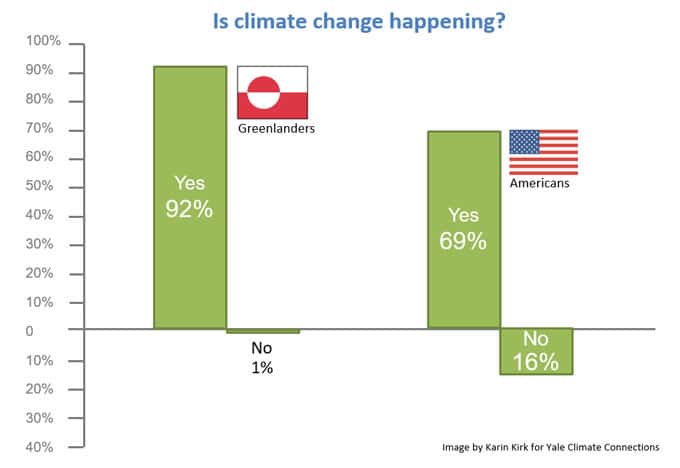
The vast majority of people living in Greenland say the climate is changing. The Arctic is warming more than twice as fast as the rest of the world, and the results are not subtle.
“We don’t have solid sea ice in the winter anymore and the ice is melting quickly,” said one resident in Avannaata, in the northwest of Greenland. “Some of the glaciers are becoming smaller than before, and glaciers now release icebergs all year round.”
Most Greenlanders Have Experienced the Effects of Climate Change
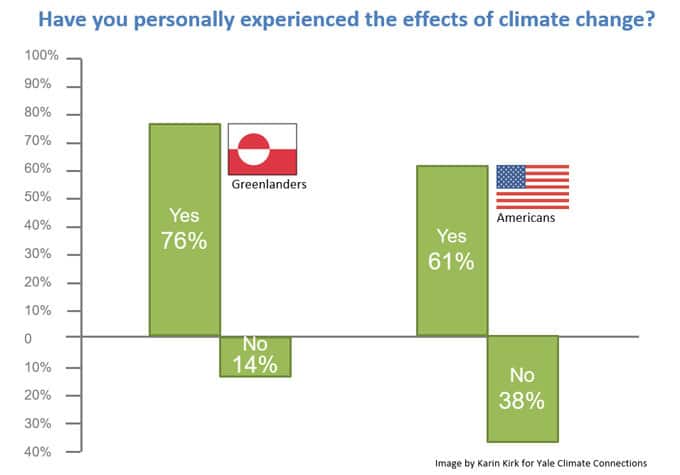
The Greenlandic way of life is close to nature. Most Greenlanders (76%) eat wild foods they hunt, fish or gather. Nearly one-quarter went out on the sea ice in the past year. Many live within sight of a glacier. The Greenlandic Inuit have long relied on nature for their livelihoods. One resident explained, “It is really bad because my parents are fishermen. If the weather is not stable, their economy is unstable.”
Climate Change Is an Important Issue in Greenland
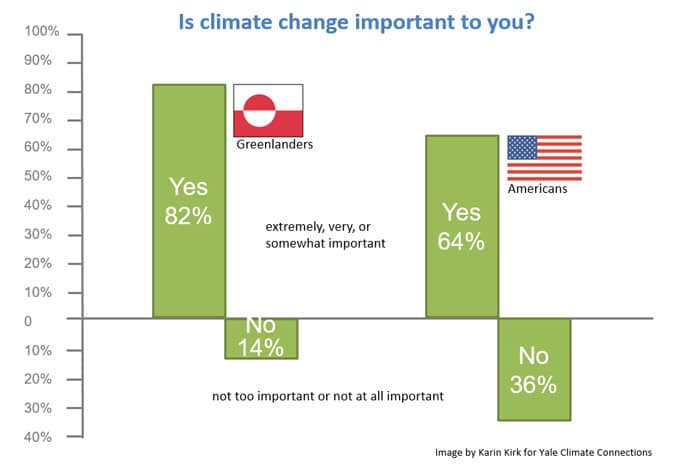
For wealthy nations in temperate climates, such as the U.S., climate change has only recently become an important issue among voters, despite decades of concern from scientists. But in Greenland, climate conditions are not an abstraction: Ice, snow and weather are central to their lives. Climate change is important to 82% of Greenlanders, compared with 64% of Americans.
Greenlanders spoke about local impacts: “The fish factory closed down in 2012 because the sea ice from the fjord side stopped forming.” And they speak also of the global reach of the problem: “The ice sheet is melting and will be bad for both us and the world.”
Frequent Discussions Among Greenlanders About Climate Change

As one might expect given the responses above, Greenlanders frequently talk about climate change. “We talk about the big changes in the weather almost every day,” said one respondent. About one-quarter of Americans say they never discuss climate change; in Greenland, nearly half (45%) discuss it weekly or monthly.
A Slim Majority of Greenlanders Point to Human Activities

Given Greenlanders’ reactions to the other questions, it’s somewhat surprising that only a narrow majority thinks that human activities are warming the climate. The data from this question are similar to data on public opinion in the U.S., with the caveat that people’s attitudes in both locations can change over time.
But the similar results likely stem from different reasons. In the U.S., acceptance of humans as a driving factor in climate change has divided along political lines, and partisan rhetoric to ignore or deny climate change remains a persistent distraction.
Greenland does not share the fractious politics of the U.S., so it’s unlikely that partisanship or fossil fuel lobbying are at the root of public opinion. But Greenland residents are disconnected from the driving causes of climate change. Citizens of industrialized nations are accustomed to seeing smoke stacks, vast industrial sites, and, in many areas, a gauze of pollution in the air. Greenland has none of that. Instead, natural forces dominate their daily lives. The scale of pollution in industrialized countries is as foreign to the Inuit culture as polar bears are to most Americans.
Local Risks, Impacts and Perceptions
When Greenlanders talk about climate change, their observations and worries differ markedly from those of Americans. Subsistence hunting and fishing are still part of the Greenlandic way of life, and the Inuit are personally exposed to the hazards and hardships of a rapidly changing environment.
A resident in Qeqertalik, West Greenland, voiced a local concern, “The food-chain is becoming unpredictable, and animals in the Arctic are getting closer to towns, which is uncomfortable.”
Violent Weather and Unpredictable Sea Ice as Top Problems
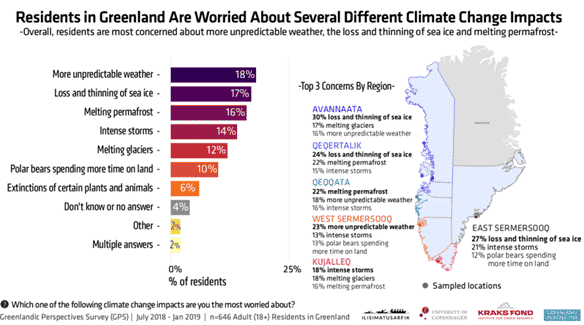
When it comes to specific climate impacts, people’s observations reflect their particular circumstances. In southern areas of Greenland, unpredictable weather and increasing storminess rank as the top concerns. “More frequent, very powerful storms are very worrisome,” said a West Sermersooq local.
In the northern and eastern regions of the country, the loss and thinning of sea ice are the most vexing impacts of climate change. A large majority (79%) of Greenland residents say they feel traveling on sea ice has become more dangerous in recent years: “Due to climate change, we get less sea ice in the winter, making it harder to make a living from [it].”
Who Will Be Most Harmed by Climate Change? Sled Dogs
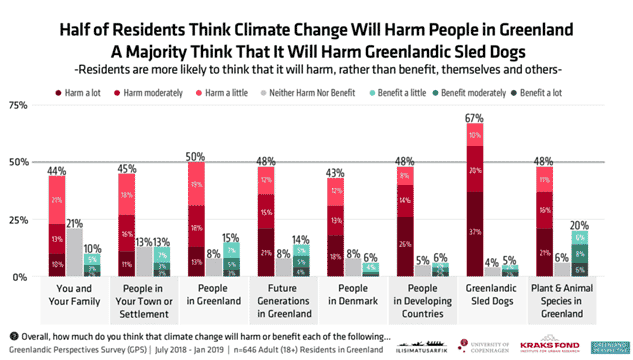
Greenland residents say those most likely to suffer harm from climate change are not people, not children, and not future generations. It’s sled dogs. Two-thirds of Greenlanders say they think their dogs will be harmed by climate change, as opposed to 50% who feel Greenlanders themselves will be harmed.
One respondent said in an interview, “I used to dogsled a lot when I grew up. My children didn’t experience this because they were too late for sea ice.”
Not All Think the Changes Will Be Bad
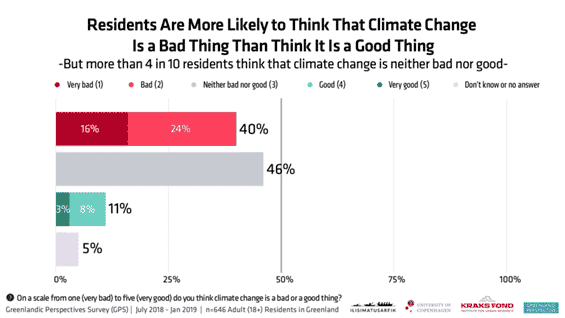
In the Arctic, the allure of a longer or warmer summer has some appeal. Even so, four times as many people think climate change is a bad thing than think it’s beneficial. Nearly half the population feels the changes are neither bad nor good.
“It is nice that the climate is warming but bad globally,” said one resident. Others mentioned the possibility of saving money on heating oil and electricity.
Melting ice may have benefits for navigation and agriculture. “It might make the Northwest passage more sailable, which could be good for Greenlandic society’s economy and infrastructure,” said a resident of West Sermersooq, Greenland’s most populous region. A respondent in Avannaata, situated well north of the Arctic Circle, said, “I’m not sure it is going to harm us. In the future, I would like to try farming after we move south. It should benefit farming.”
One West Greenlander reflected on a consequence of the melting ice that would reap local benefits along with global concerns, “We may get greater access to gas, oil and natural resources.”
Most Greenlanders Back Limits on Greenhouse Emissions

Even though Greenland is a negligible contributor to the world’s burgeoning outpouring of greenhouse gases, residents say they favor measures to limit their own pollution. Investments in renewable energy are the most attractive approach, with 75% approval and only 2% opposition. Most Greenlanders favor regulation of industrial greenhouse gas emissions and feel that Greenland should be part of the Paris climate agreement. Denmark is a member of the Paris agreement, but was granted a “territorial exclusion” for Greenland. Greenland did not enter the Paris agreement because resource extraction is one of its few options for economic development. This outlook is reflected in the opinion data; banning oil drilling does not garner majority support, even though citizens support emissions reductions in other ways. About 40% of residents say they prefer protecting the environment even if it costs jobs, and 26% say they favor economic growth over environmental protection.
“Because of the climate change, it can be challenging for the fishers but we always adapt,” said a Qeqqata local. “We have to contribute to spreading awareness and preventing pollution.”
Greenland’s climate is harsh even in the best of circumstances, and climate impacts to Inuit lives present a first-order challenge. Nonetheless, many have a broad view of the problem. “It has been very cold in Greenland the last months, while it is so hot in the other countries. The people in other countries are dying due to the fires. If global warming happens everything will be rotten.”
For many people around the world, the bottom line remains the same, whether uttered by someone in Albuquerque or in Avannaata: “If people stop polluting earth, maybe climate change won’t be as drastic.”
Editor’s note: Anthony Leiserowitz, Director of the Yale Program on Climate Change Communication, served in an advisory role on the Greenlandic study.
References
Minor, K., Agneman, G., Davidsen, N., Kleemann, N., Markussen, U., Olsen, A., Lassen, D., Rosing, MT. (2019). Greenlandic Perspectives on Climate Change 2018-2019 Results from a National Survey. University of Greenland and University of Copenhagen. Kraks Fond Institute for Urban Research.
Leiserowitz, A., Maibach, E., Rosenthal, S., Kotcher, J., Bergquist, P., Ballew, M., Goldberg, M., & Gustafson, A. (2019). Climate change in the American mind: April 2019. Yale University and George Mason University. New Haven, CT: Yale Program on Climate Change Communication.
Reposted with permission from our media associate Yale Climate Connections.
- Greenland Lost an Unprecedented Amount of Ice in 2019, Study Finds - EcoWatch
- 'We Need to Act Now': Glaciers Melting at Unprecedented Pace, Study Reveals
- 'Ecological grief': Greenland residents traumatised by climate ...
- Europe's Heat Wave, Fueled by Climate Change, Moves to Greenland
- Guest post: How the Greenland ice sheet fared in 2019 | Carbon Brief
- Opinion: Trump distracts from Greenland's grave climate emergency ...
- At the bottom of a glacier in Greenland, climate scientists find ...

 233k
233k  41k
41k  Subscribe
Subscribe 